AUDI A3 CABRIOLET 2015 Owners Manual
Manufacturer: AUDI, Model Year: 2015, Model line: A3 CABRIOLET, Model: AUDI A3 CABRIOLET 2015Pages: 302, PDF Size: 73.83 MB
Page 141 of 302

....,
N
" > co
rl I.O
"' ,....,
"' rl
-Failure to pay attention to the warning
light that come on, could lead to person
al injury.
Why safety belts?
Frontal collisions and the law of physics
Frontal crashes create very strong forces for
people riding in vehicles .
Fig. 1 31 Unb elt e d oc cupan ts in a ve hicle h ead ing for a
wall
Fig. 132 T he vehicle c ras hes into the wall
The physical principles are simple. Both the
veh icle and the passengers possess energy
which varies w ith veh icle speed and body
weight . Engineers call this energy "kinetic en
e rgy."
T he higher the speed of the vehicle and the
greater the vehicle's weight, the more energy
that has to be "absorbed" in the crash .
Vehicle speed is the most significant factor . If
the speed doubles from 15 to 30 mph (25 to
50 km/h), the ene rgy increases 4 t imes!
Because the passengers of th is veh icle are not
using safety belts
c:::;, fig. 131, they will keep
mov ing at the same speed the vehicle was
mov ing just befo re the crash, unt il something
stops them - here, the wall ¢
fig. 132 .
Safety belts 139
The same principles apply to people s itting in
a vehicle that is involved in a frontal coll ision .
Even at c ity speeds of 20 to 30 mph (30 to
SO km/h), the forces acting on the body can
reach one ton (2,000 lbs, or 1,000 kg) or
more . At greater speeds, these fo rces are even
highe r.
Peop le who do not use safety belts are also
not attached to their vehicle . In a frontal colli
s ion they will also keep moving forward at the
speed their veh icle was travel ling just before
the crash . Of co urse, the laws of physics don't
just app ly to frontal collisions, they determine
what happens i n all k inds of a cc ident s and col
li s ions .
What happens to occupants not wearing
safety belts?
In crashes unbelted occupants cannot stop
themselves from flying forward and being in
jured or killed . Always wear your safety belts!
Fi g. 1 33 A drive r not wear ing a safety bel t is v io len tly
t hrown forward
Fig . 1 34 A rear pa sse nger not wearing a safety be lt
w ill fl y forw ar d a nd str ike t he dr ive r
Unbelted occupants are not able to resist the
tremendous forces of impact by holding tight
or bracing themselves . Without the benefit of
safety restra int systems, the unrestra ined ..,_
Page 142 of 302
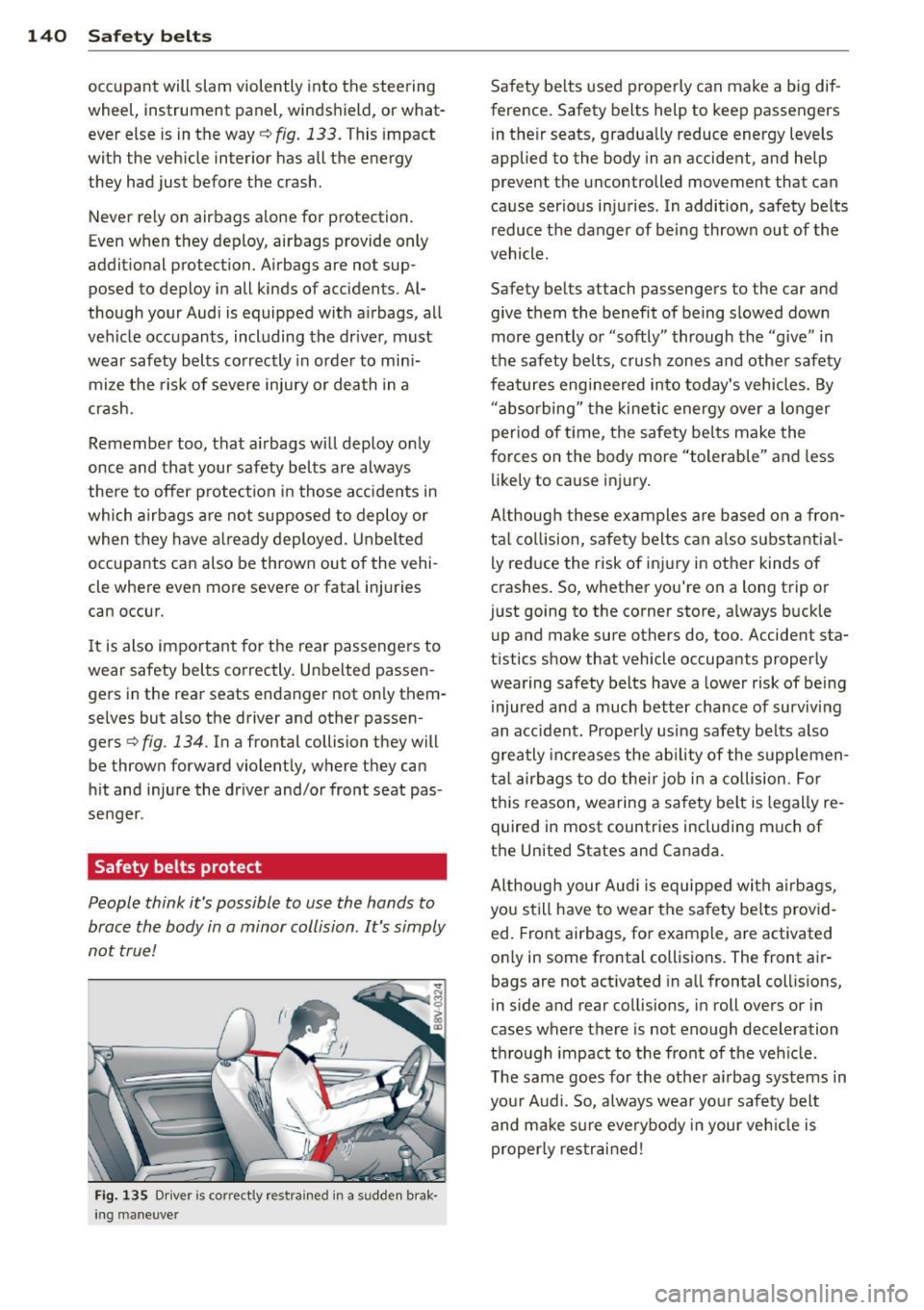
140 Safety belts
occupant will slam violently into the steering
wheel, instrument panel, windshield, or what
ever else is in the way
c::> fig. 133. This imp act
with the vehicle interior has all the energy
t hey had just before the crash.
Never rely on a irbags alone for protection.
Even when they deploy, airbags provide only
additional protection. Airbags are not sup
posed to deploy in all kinds of accidents. Al
though your Audi is equipped with airbags, all
vehicle occupants, including the driver , must
wear safety belts correctly in order to mini
mize the risk of severe injury or death in a
crash.
Remember too, that airbags will deploy only
once and that your safety belts are always
there to offer protection in those accidents in
which airbags are not supposed to deploy or
when they have already deployed . Unbelted
occupants can also be thrown out of the vehi
cle where even more severe or fatal injuries
can occur.
It is also important for the rear passengers to
wear safety belts correctly. Unbelted passen
gers in the rear seats endanger not only them
selves but also the driver and othe r passen
gers ~
fig. 134. In a frontal collision they will
be thrown forward violently, where they can
hit and injure the driver and/or front seat pas
senger .
Safety belts protect
People think it's possible to use the hands to
brace the body in a minor collision . It's simply
not true !
Fig. 135 Driver is co rr ect ly re strain ed in a sudd en brak
ing maneuve r
Safety belts used properly can make a big dif
ference. Safety belts help to keep passengers
in their seats, gradually reduce energy levels
applied to the body in an accident, and help
prevent the uncontrolled movement tha t can
cause serious injuries . In addition, safety belts
reduce the danger of being thrown out of the
vehicle .
Safety belts attach passengers to the car and
give them the benefit of being slowed down
more gently or "softly" through the "give" in
the safety belts, crush zones and other safety
features engineered into today's vehicles. By
"absorbing " the kinetic energy over a longer
period of ti me, the safety belts make the
forces on the body more "tolerable" and less
likely to cause injury.
Although these examples are based on a fron
tal collision, safety belts can also substantial
ly reduce the r isk of injury in other kinds of
crashes. So, whether you're on a long trip or
just going to the corner store, always buckle up and make sure others do, too. Accident sta
tistics show that vehicle occupants properly
wearing safety belts have a lower risk of being
injured and a much better chance of surviving
an accident. Properly using safety belts also
greatly increases the ability of the supplemen
tal airbags to do their job in a collision . For
this reason, wearing a safety belt is legally re
quired in most countries including much of
the United States and Canada.
Although your Audi is equipped with airbags,
you still have to wear the safety belts provid
ed. Front airbags , for example, are activated
only in some frontal collisions. The front air
bags are not activated in all frontal collisions,
in side and rear collisions, in roll overs or in
cases where there is no t enough decelera tion
through impact to the front of the vehicle .
The same goes for the other airbag systems in
your Audi . So, always wear your safety belt
and make sure everybody in your vehicle is
properly restrained!
Page 143 of 302
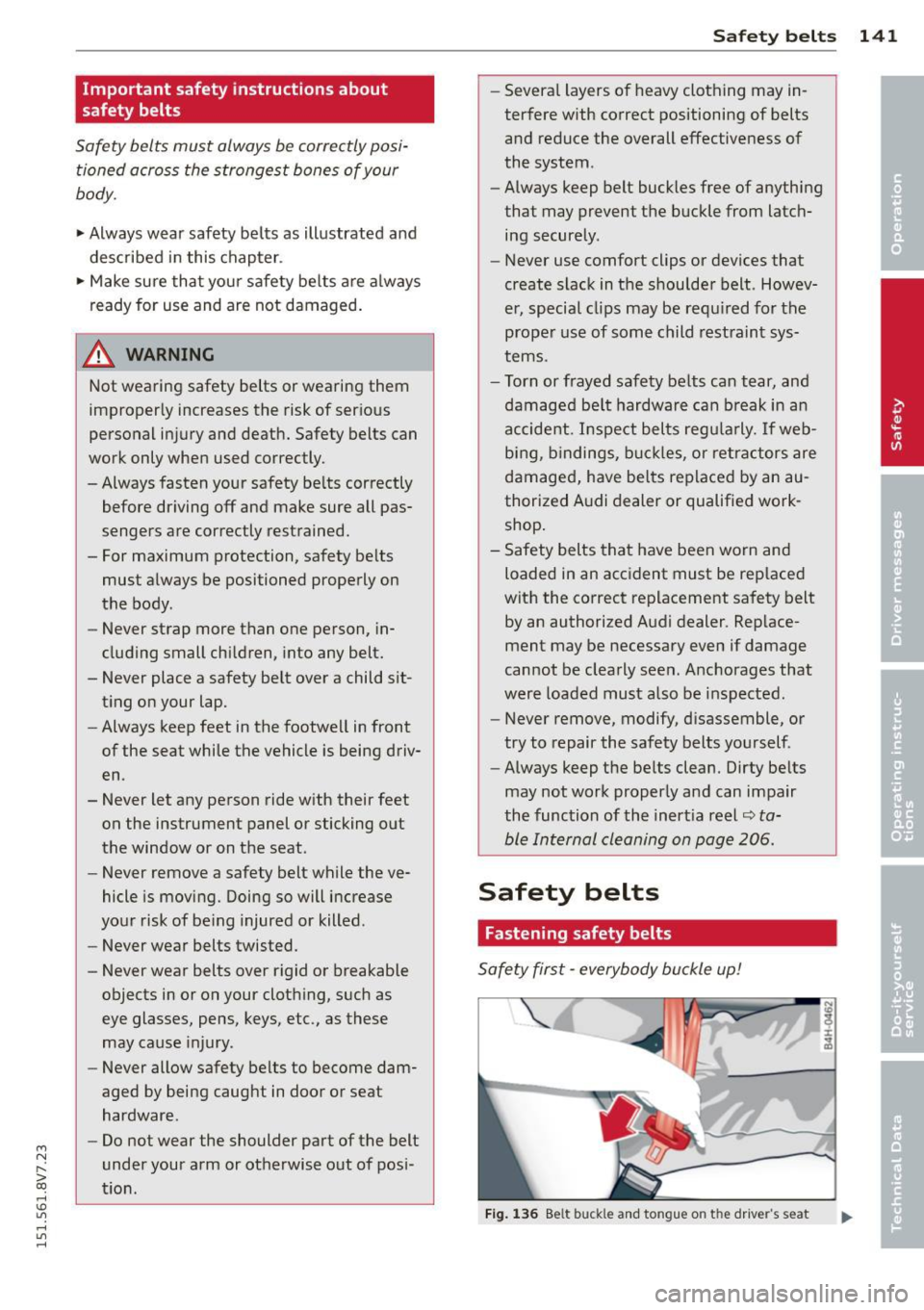
....,
N
r--. > co
rl I.O
"' rl
"' rl
Important safety instructions about
safety belts
Safety belts must always be correctly posi
tioned across the strongest bones of your
body.
~ Always wear safety belts as illustrated and
described in this chapter.
~ Make sure that your safety belts are always
ready for use and are not damaged.
A WARNING
Not wearing safety belts or wearing them
improperly increases the risk of serious
personal injury and death. Safety belts can
work only when used correctly.
- Always fasten your safety be lts correctly
before driving off and make sure all pas
sengers are correctly restrained.
- For maximum protection, safety belts must always be positioned properly on
the body .
- Never strap more than one person, in
cluding small children, into any belt.
- Never place a safety belt over a child sit ting on your lap.
- Always keep feet in the footwell in front
of the seat while the vehicle is being driv
en .
- Never let any person ride with their feet
on the instrument panel or sticking out
the window or on the seat.
- Never remove a safety belt while the ve
hicle is moving. Doing so will increase
your risk of being injured or killed.
- Never wear belts twisted.
- Never wear belts over rigid or breakable
objects in or on your clothing, such as
eye glasses, pens, keys, etc., as these may cause injury.
- Never allow safety belts to become dam
aged by being caught in door or seat
hardware .
- Do not wear the shoulder part of the belt
under your arm or otherwise out of posi
tion .
Safety belts 141
-Severa l layers of heavy clothing may in
terfere with correct positioning of belts and reduce the overall effectiveness of
the system .
- Always keep belt buckles free of anything
that may prevent the buckle from latch
ing securely .
- Never use comfort clips or devices that
create slack in the shoulder belt . Howev
er, special clips may be requ ired for the
proper use of some child restraint sys
tems .
- Torn or frayed safety belts can tear, and
damaged belt hardware can break in an
accident. Inspect belts regularly.
If web
bing , bindings, buckles, or retractors are
damaged, have belts replaced by an au
thorized Audi dealer or qualified work shop.
- Safety belts that have been worn and
loaded in an accident must be replaced
with the correct replacement safety belt
by an authorized Audi dealer . Replace
ment may be necessary even if damage
cannot be clearly seen . Anchorages that
were loaded must also be inspected.
- Never remove, modify, disassemble, or
try to repair the safety belts yourself.
- Always keep the bel ts clean. Dirty belts
may not work properly and can impair
the function of the inertia reel~
ta
ble Internal cleaning on page 206.
Safety belts
Fastening safety belts
Safety first -everybody buckle up!
Fig. 136 Bel t b uckle and to ngue on the drive r's seat
Page 144 of 302
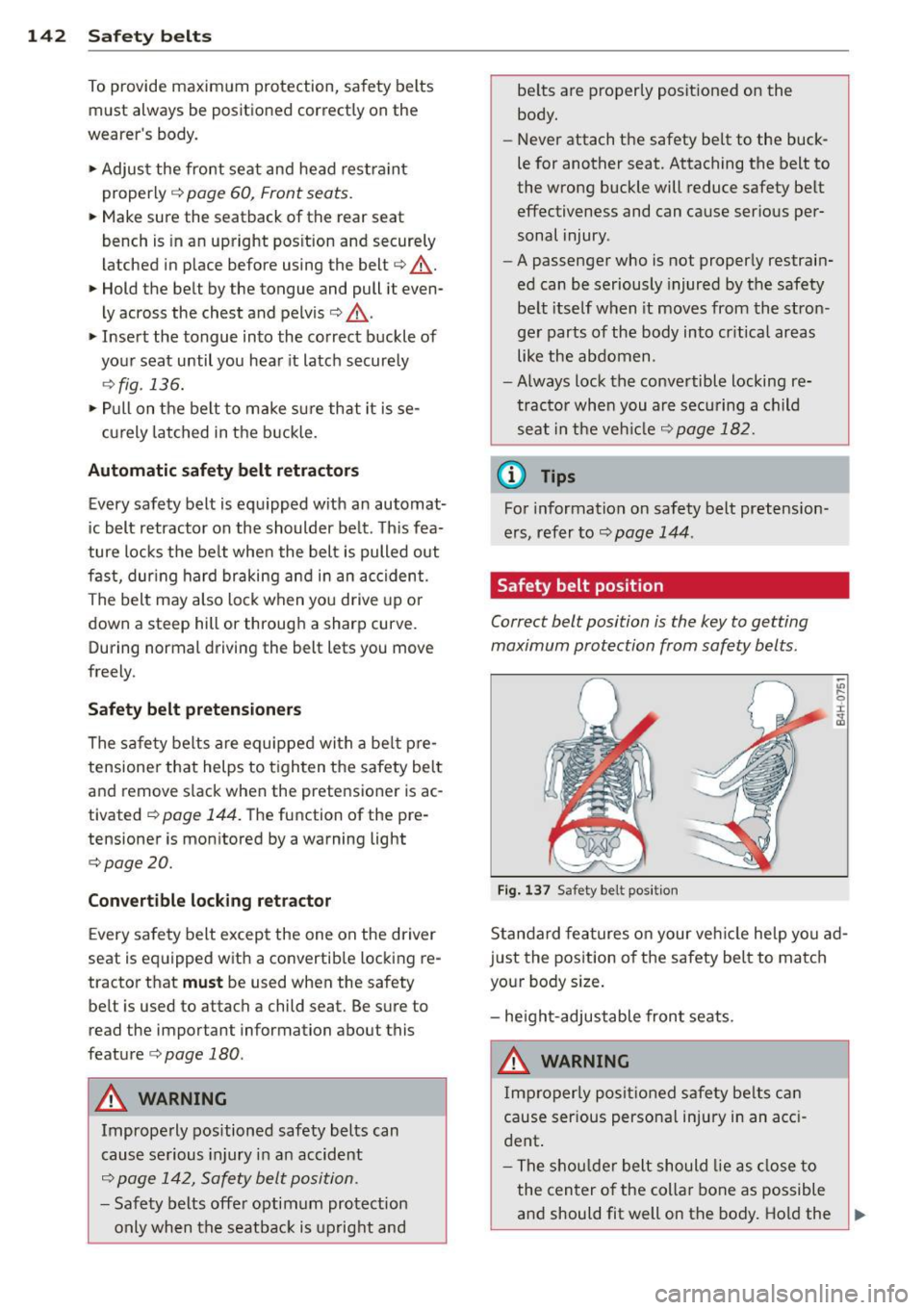
142 Safet y belt s
To provide maximum protection, sa fety belts
must always be positioned correctly on the
wearer 's body .
.,. Adjust the front seat and head restr aint
properly ¢
page 60, Front seats .
.,. Make sure the seatback of the rear seat
bench is in an upright pos ition and securely
latched in place befo re using the belt¢.&, .
.,. Hold the belt by the tongue and pull it even
l y across the chest and pelvis¢.&, .
.,. Inse rt the tongue into the correct buckle of
you r seat until you hea r it latch securely
¢ fig . 136.
.,. Pull on the be lt to m ake s ure th at it is se-
curely latched in the b uckle .
Automatic safety belt retractors
Every safety belt is eq uipped w ith an automat
ic belt retractor on the shoulder be lt . T his fea
ture locks the be lt when the belt is pulled out
fast, dur ing hard bra king and in an acci dent.
The belt may also lock when yo u drive up or
down a steep hill or through a sharp curve. During normal driving the belt lets you move
freely .
Safety belt pret ensioners
The sa fe ty belts are equippe d wi th a be lt pre
tensioner that helps to tigh ten the safety bel t
and remove s lack when the pretensioner is ac
tivated ¢
page 144. The function of the pre
tensioner is monitored by a warning light
¢page 20.
Convert ible locking ret ractor
E very sa fe ty belt except the one on the dr iver
seat is eq uipped with a convertib le locking re
tractor that
must be used when the safety
be lt is used to attach a child seat. Be s ure to
read the important information about this
feature ¢
page 180 .
A WARNING
Improperly positioned safety belts can
cause se rious injury in an accident
¢ page 142, Safety bel t p osition.
- Saf ety belts offe r optim um pro te ction
only wh en the seatba ck is upr ight and be
lts are properly posit ioned on the
body.
- Never attach the safety be lt to the buck
le for another seat. Attaching the belt to
the wrong buckle will reduce safety be lt
effectiveness and can cause serious per
sonal injury .
- A passenger who is not proper ly restrain
ed can be seriously injured by t he safety
be lt itse lf w hen it moves from the stro n
ge r parts of the body into cr itica l areas
like the abdomen .
- Always lock the conve rtible locking re
tracto r when you are secu ring a child
seat in t he ve hicl e¢
page 182.
© Tips
Fo r information on safety belt pretens ion
ers, refer to¢
page 144.
Safety belt position
Correct belt position is the key to getting
maximum protection from safety belts .
Fig. 137 Safet y bel t pos it ion
Stan dard fea tures o n your veh icle he lp yo u ad
ju st the pos ition o f th e safety be lt to ma tch
your body s ize .
- he ight-adjus table fron t seats.
A WARNING
Imp ro pe rl y pos it io ned safety be lts ca n
cause ser ious perso nal injury in an a cci
dent.
-
- T he s hou lder be lt should lie as close to
the center o f the collar bone as possible
an d should fit well on the body. Hol d the
~
Page 145 of 302
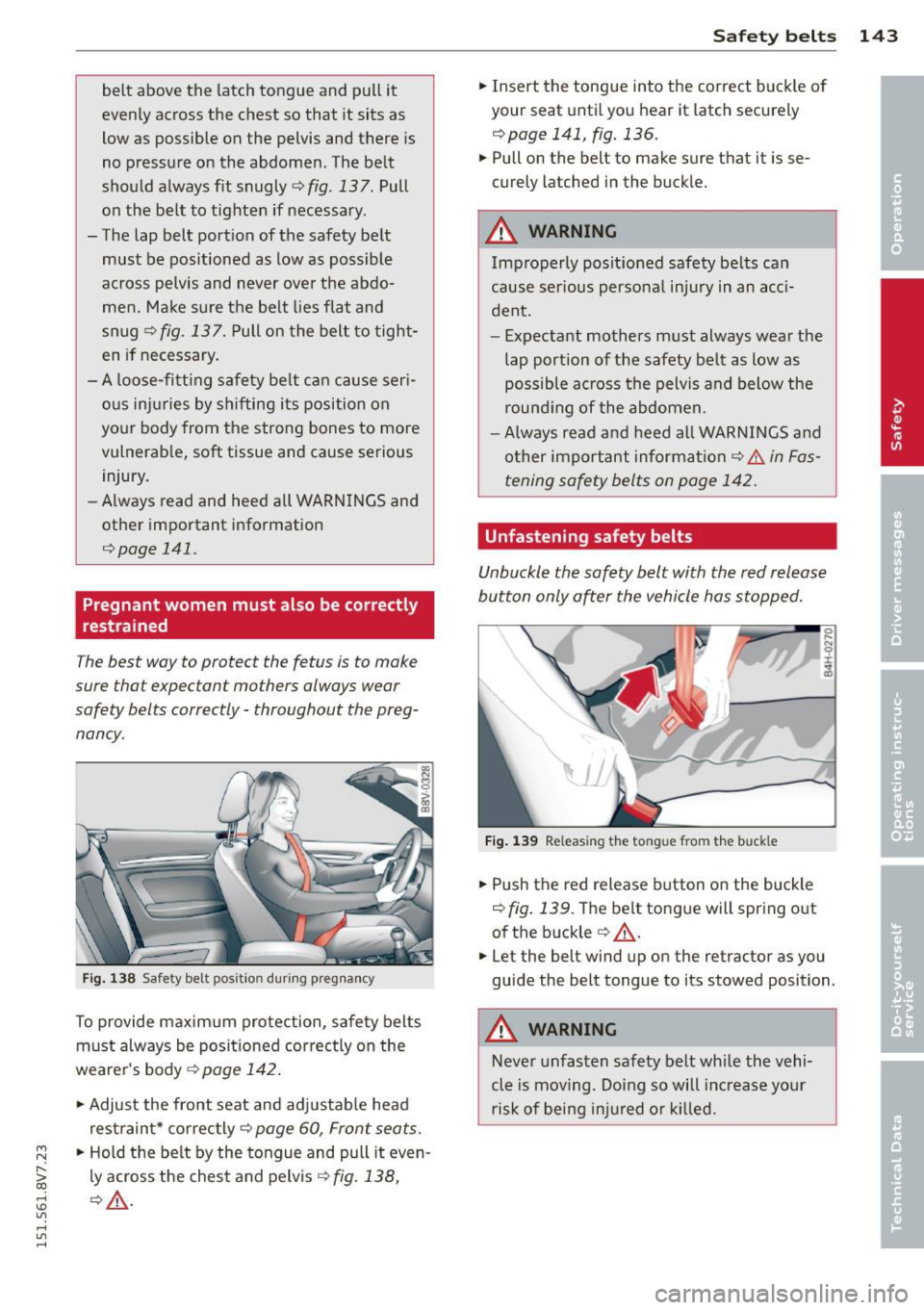
....,
N
r--. > co
rl I.O
"' rl
"' rl
belt above the latch tongue and pull it
evenly across the chest so that it sits as
low as possible on the pelvis and there is
no pressure on the abdomen. The belt
should always fit snugly
r=:> fig. 137 . Pull
on the belt to tighten if necessary.
- The lap belt port ion of the safety belt
must be positioned as low as possible
across pelvis and never over the abdo
men. Make sure the belt lies flat and
snug
c:> fig . 137. Pull on the belt to tight
en if necessary.
- A loo se-fitting safety belt can cause seri
ous injuries by sh ifting its position on
your body from the strong bones to more
vulnerable, soft tissue and cause serious
injury.
- Always read and heed all WARNINGS and
other important information
r::;, page 141.
Pregnant women must also be correctly
restrained
The best way to protect the fetus is to make
sure that expectant mothers always wear
safety belts correctly -throughout the preg
nancy.
Fig. 138 Safety belt pos itio n during pregnancy
To provide maximum protection, safety belts
must always be positioned correctly on the
wearer's body
c:> page 142 .
.. Adjust the front seat and adjustable head
restraint* correctly
c:> page 60, Front seats .
.. Hold the belt by the tongue and pull it even
ly across the chest and pelvis
r:!> fig. 138,
QA .
Safety belts 143
.. Insert the tongue into the correct buckle of
your seat until you hear it latch securely
<=:>page 141, fig. 136.
.. Pull on the belt to make sure that it is se
curely latched in the buckle.
A WARNING
Improperly positioned safety belts can
cause ser ious personal injury in an acc i
dent.
- Expectant mothers must always wear the
lap portion of the safety belt as low as
possible across the pelvis and below the
round ing of the abdomen.
- Always read and heed all WARNINGS and
other important information
c:> & in Fas
tening safety belts on page 142.
Unfastening safety belts
Unbuckle the safety belt with the red release
button only a~er the vehicle has stopped.
.. J_
Fig. 139 Releas ing the tongue fro m the buck le
.. Push the red release button on the buckle
r=:> fig. 139. The belt tongue will spring out
of the buckle
r::;, ,&. .
.. Let the belt wind up on the retractor as you
guide the belt tongue to its stowed position .
A WARNING
--Never unfasten safety belt while the vehi
cle is moving . Doing so will increase your
risk of being injured or kill ed.
Page 146 of 302
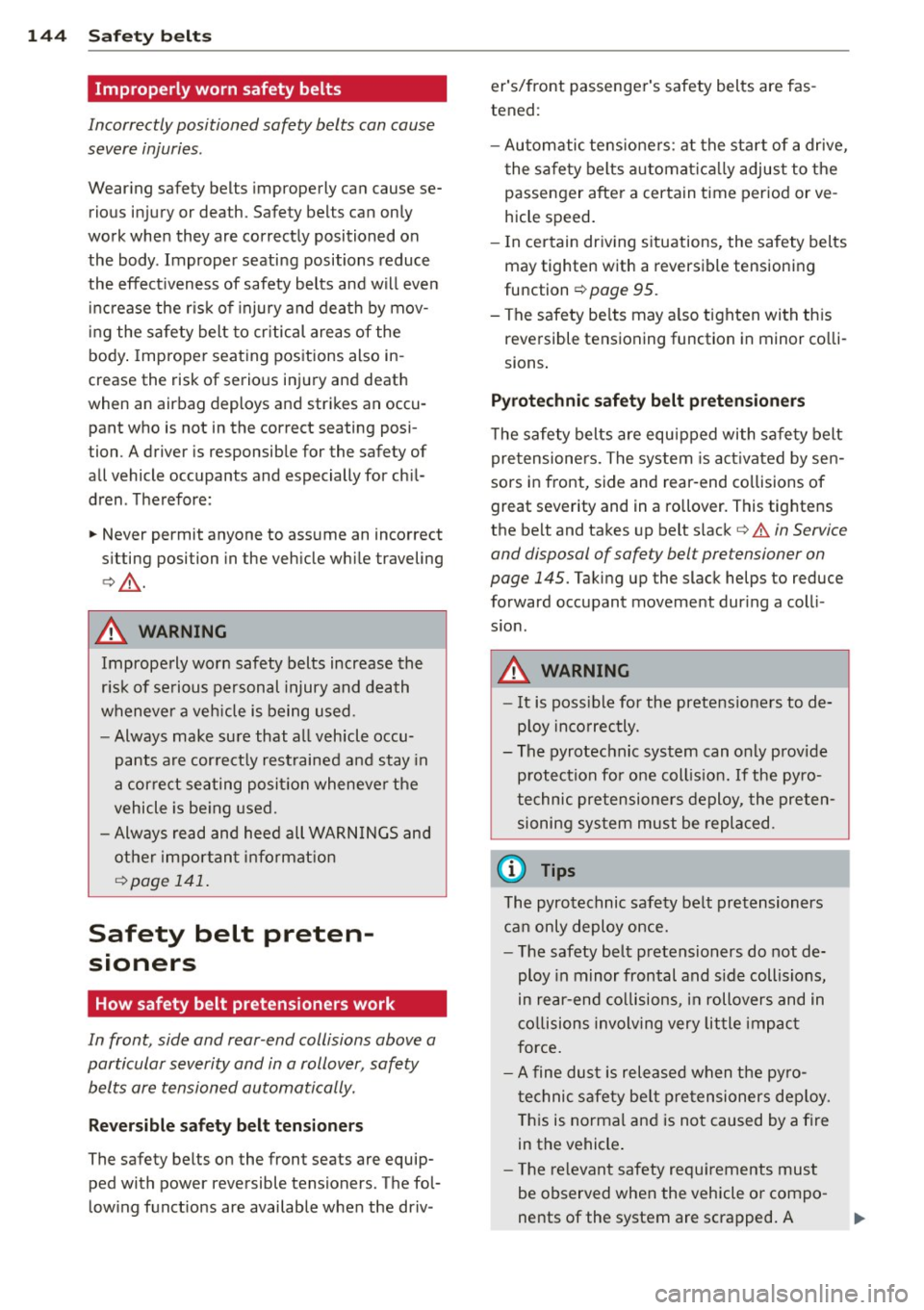
144 Safety belts
Improperly worn safety belts
Incorrectly positioned safety belts can cause
severe injuries .
Wearing safety belts improperly can cause se
rious injury or death. Safety belts can only
work when they are correctly positioned on
the body . Improper seating positions reduce
the effect iveness of safety belts and will even
i ncrease the r isk of injury and death by mov
ing the safety belt to cr itical areas of the
body . Improper seating positions also in
crease the risk of serio us inj ury and death
when an airbag deploys and strikes an occu pant who is not in the correct seating posi
tion . A driver is responsible for the safety of
all vehicle occupants and especially for ch il
dren . Therefore:
.. Never permit anyone to assume an incorrect
sitting position in the vehicle wh ile traveling
¢ _& .
A WARNING
Improperly worn safety belts increase the
risk of se rious personal injury and death
whenever a veh icle is being used .
- Always make sure that al l vehicle occu-
pants are cor re ct ly restrained a nd stay in
a corre ct seating posit ion wheneve r the
vehicle is be ing used.
- Always read and heed all WARNI NGS and
other important informat ion
¢page 141.
Safety belt preten
sioners
How safety belt pretensioners work
In front, side and rear -end collisions above a
particular severity and in a rollover , safety
belts are tensioned automatically.
R ev er sible s afety belt ten sioners
The safety belts on the front seats are equip
ped with power reve rsible tensioners . The fol
low ing funct ions are available when the driv -er's/front passenger's safety belts are fas
tened:
- Automatic tens ioners : at the start of a dr ive,
t he sa fe ty belts automat ica lly adjust to the
passenger after a certain time period or ve
hicle speed.
- In certain driving situations, the safety belts
may tighten w ith a reversible tensioning
function
¢ page 95.
-The safety be lts may a lso tighten with this
reversible tensioning function in minor co lli
sions .
Pyrotechnic s afety belt pretens ioners
T he safety belts are equipped with sa fety belt
pretensioners. The system is ac tivated by sen
sors in front, side and rear-end co llisions of
great severity and in a rollover. This tightens
the belt and takes up belt slack ¢.&.
in Service
and disposal of safety belt pretensioner on
page 145.
Taking up the slack helps to reduce
forward occupant movement dur ing a colli
s ion .
A WARNING
-- It is poss ible for the pretens ioners to de-
p loy inco rrectly.
- The pyrotechnic system can only provide
p rotection fo r one coll is ion. If the pyro
technic pretensioners deploy, the preten sioning sys tem must be replaced .
{!) Tips
The pyrotechnic safety be lt pretensioners
can only deploy once.
- The safety belt pretensioners do not de
ploy in minor frontal and s ide collisions,
in rear-end co llisions, in rollovers and in
co llisions involving very little impact
force.
- A fine dust is released when the py ro
t echnic safety be lt pretensioners dep loy.
T his is normal and is not caused by a fire
in the vehicle .
- T he re levant safety requ irements must
be observed when the vehicle or compo
nents of the system are scrapped. A
Page 147 of 302
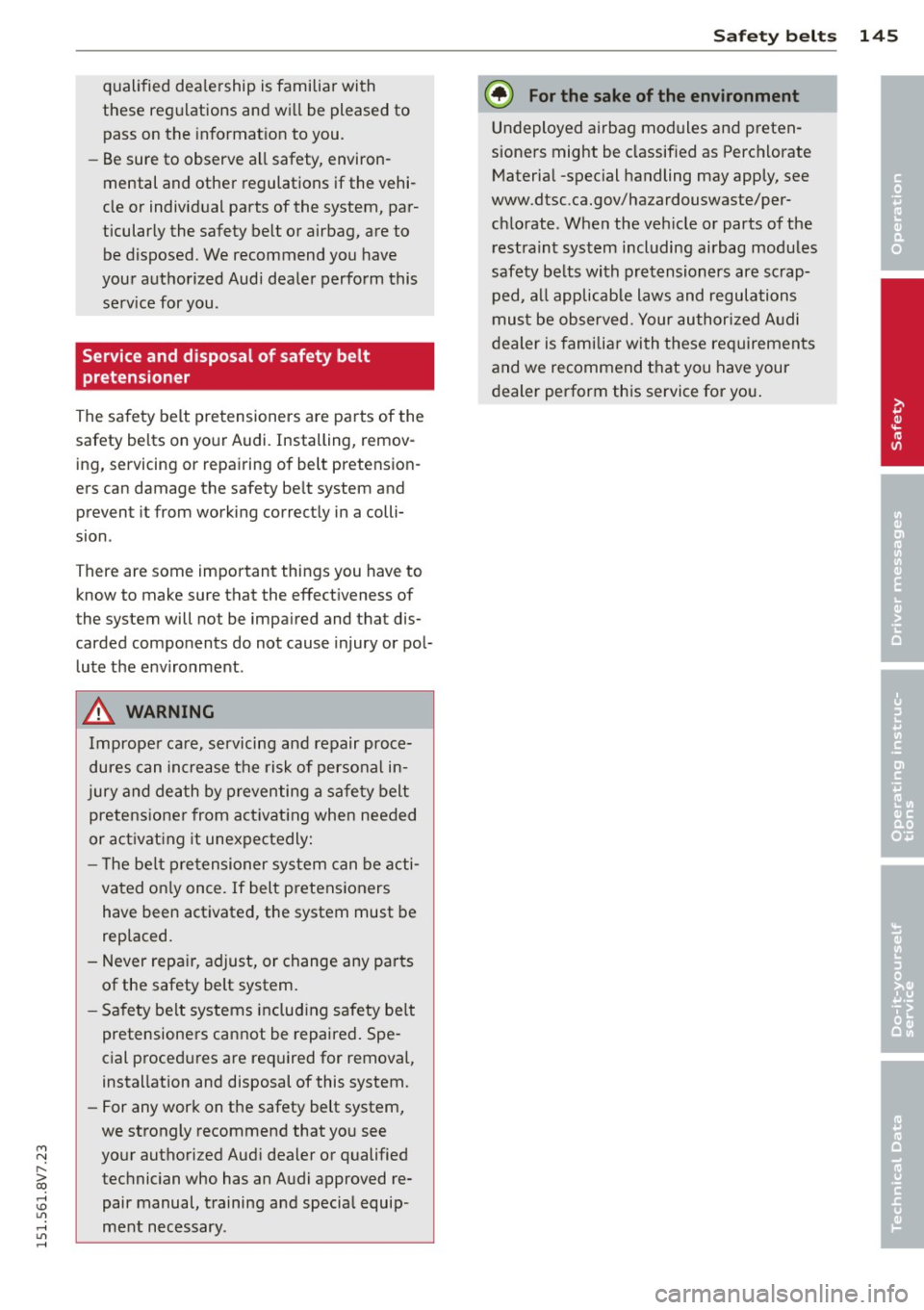
M N
" > co ,...., \!) ..,.,
,...., ..,., ,....,
qualified dealership is familiar with
these regulations and will be pleased to pass on the information to you.
- Be sure to observe all safety, environ
mental and other regulations if the vehi
cle or individual parts of the system, par
ticularly the safety belt or airbag, are to be disposed. We recommend you have
your authorized Audi dealer perform this
service for you.
Service and disposal of safety belt
pretension er
The safety belt pretensioners are parts of the
safety belts on your Audi. Installing, remov ing, servicing or repairing of belt pretension
ers can damage the safety belt system and
prevent it from working correctly in a colli
sion.
There are some important things you have to
know to make sure that the effectiveness of
the system will not be impaired and that dis
carded components do not cause injury or pol
lute the environment .
A WARNING
Improper care, servicing and repair proce
dures can increase the risk of personal in
jury and death by preventing a safety belt
pretensioner from activating when needed
or activating it unexpectedly:
- The belt pretensioner system can be acti
vated only once. If belt pretensioners
have been activated, the system must be
replaced.
- Never repair, adjust, or change any parts
of the safety belt system.
- Safety belt systems including safety belt
pretensioners cannot be repaired. Spe
cial procedures are required for removal,
installation and disposal of this system.
- For any work on the safety belt system,
we strongly recommend that you see
your authorized Audi dealer or qualified technician who has an Audi approved repair manual, training and special equip
ment necessary.
Safety belts 145
@:) For the sake of the environment
Undeployed airbag modules and preten
sioners might be classified as Perchlorate
Material -special handling may apply, see
www. dtsc. ca.gov/hazard o u swa ste/ per-
ch lo rate. When the vehicle or parts of the
restraint system including airbag modules
safety belts with pretensioners are scrap
ped, all applicable laws and regulations
must be observed. Your authorized Audi
dealer is familiar with these requirements
and we recommend that you have your
dealer perform this service for you. •
•
•
Page 148 of 302
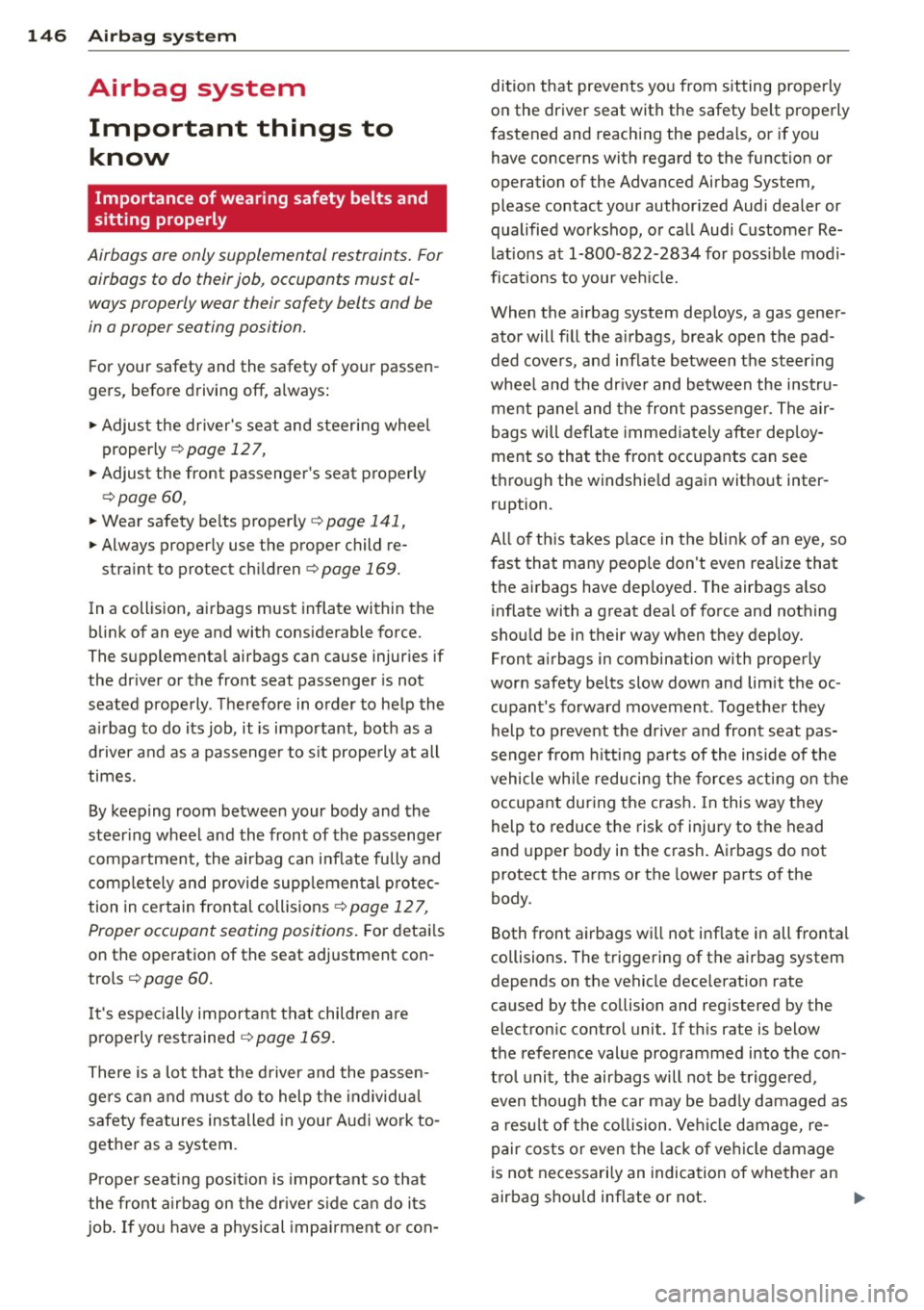
146 Airbag system
Airbag system
Important things to know
Importance of wearing safety belts and
sitting properly
Airbags are only supplemental restraints. For
airbags to do their job , occupants must al
ways properly wear their safety belts and be
in a proper seating position.
F or your safety and the safety of your passen
gers, before driving off, always:
• Adjust the driver's seat and steering wheel
properly
¢ page 127,
• Adjust the front passenger's seat properly
¢ page 60,
• Wear safety be lts properly ¢ page 141,
• Always properly use the proper child re-
straint to protect children ¢
page 169.
In a collision, airbags must inflate within the
blink of an eye and with considerable force.
The supplemental airbags can cause injuries if
the driver or the front seat passenger is not
seated properly . Therefore in order to help the
a ir bag to do its job, it is important, both as a
d river and as a passenger to sit prope rly at all
times.
By keeping room between your body and the
steering wheel and the front of the passenger
compartment, the airbag can inflate fully and
comp letely and provide supplemental protec
tion in ce rtain frontal collisions
¢page 127,
Proper occupant seating positions.
F or details
on the operation of the seat adjustment con
t rols ¢
page 60.
It's especially important that children are
properly restrained ¢
page 169.
There is a lot that the driver and the passen
ge rs can and must do to help the individual
safety features installed in your Audi work to
gether as a system.
Proper seating pos ition is important so that
the front airbag on the driver side can do its
job. If you have a physical impairment or con- dition that
prevents you from sitting properly
on the driver seat with the safety belt properly
fastened and reaching the pedals , or if you
have concerns with regard to the function or
operation of the Advanced Airbag System ,
please contact your author ized Audi dealer or
qualified workshop, or call Audi Customer Re
lations at 1-800-822-2834 for possible modi
ficat ions to your veh icle.
When the airbag system deploys, a gas gener
ator will f ill the a irbags, break open t he pad
ded cove rs, and inflate between the steering
whee l and the dr iver and between the instru
ment panel and the front passenger. The air
bags will deflate immediately after deploy
ment so that the front occupants can see
t hr ough the windshie ld again without inter
ruption .
All of this takes pla ce in the blink of an eye, so
fast that many peop le don't even realize tha t
the airbags have deployed. The airbags a lso
inflate with a great dea l of force and nothing
should be in their w ay when they deploy.
Front airbags in combination with properly
worn safety belts slow down and lim it the oc
cupant's forward movement . T ogether they
help to prevent the drive r and front seat pas
senger from hitting parts of the inside of the
vehicle while reducing the forces acting on the
occupant during the crash . In this way they
help to reduce the risk of injury to the head
and upper body in the crash. Airbags do not
protect the arms or the lower parts of the
body.
Both front airbags wi ll not inflate in all fronta l
collisions . The triggering of the airbag system
depends on the vehicle dece lerat ion rate
caused by the co llision and registered by the
electron ic control unit. If this rate is below
the reference value programmed into the con
t rol unit , the airbags will not be triggered,
even though the car may be badly damaged as
a res ult of the collision . Vehicle damage, re
pair costs or even the lack of vehicle damage
is not necessari ly an indication of whether an
airbag shou ld inflate or not.
IJll-
Page 149 of 302
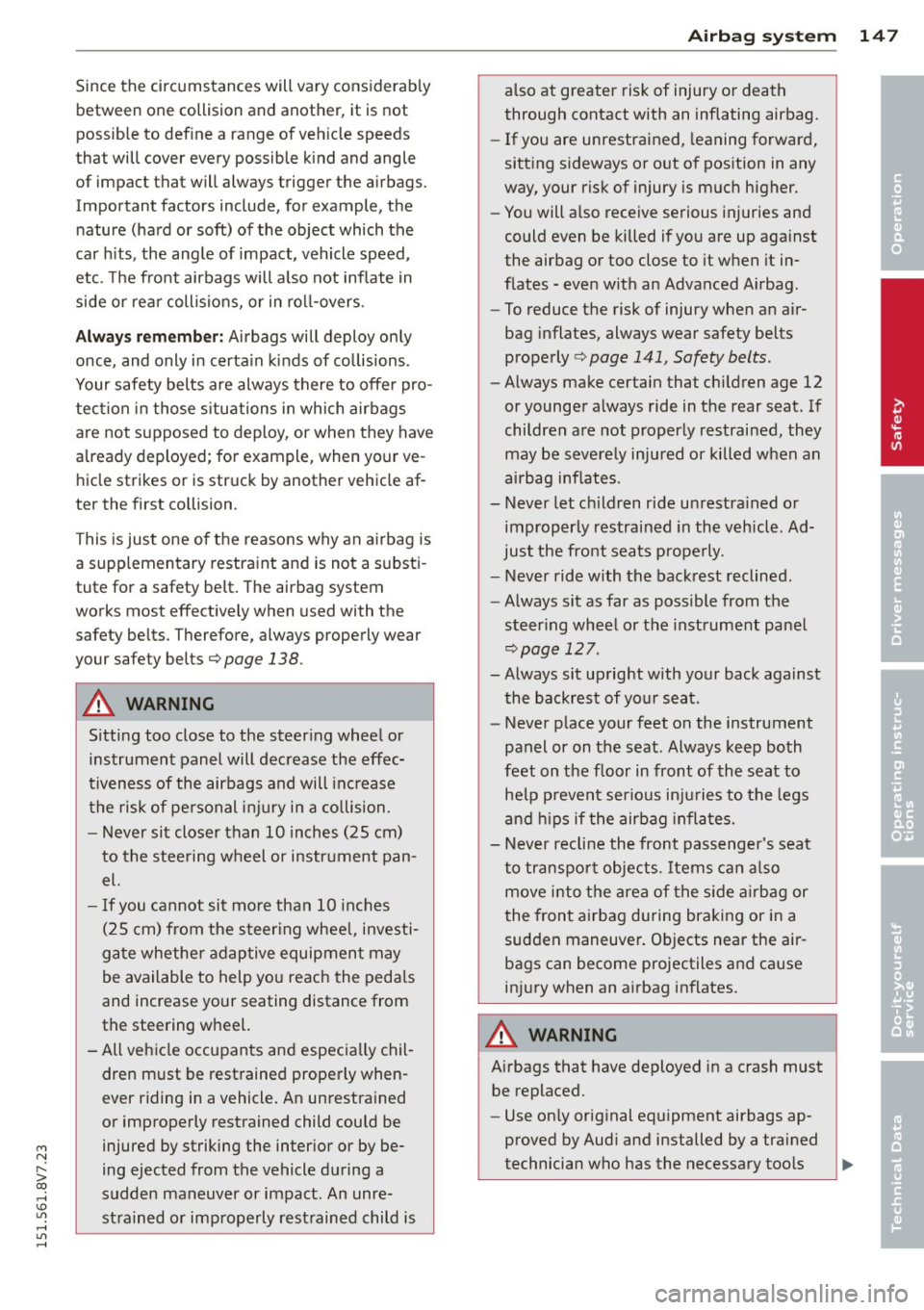
Airbag system 147
Since the circumstances will vary considerab ly
also at greater risk of injury or death
between on e collision and another , it is not
through contact with an inflating airbag .
possible to define a range of veh icle speeds
-If you are unrestrained, leaning forward,
that will cover every possible k ind and angle
sitting sideways or out of position in any
of impact that will always trigger the a irbags .
way, your risk of injury is much higher.
Important factors include, for example, the -You will a lso receive serious injuries and
nature (hard or soft) of the object which the could even be killed if you are up against
•
car h its, the ang le of impact, vehicle speed ,
• the airbag or too close to it when it in-
etc. The front airbags will a lso not inflate in
flates - even with an Advanced A irbag.
side or rea r collisions, or in ro ll-overs .
-To reduce the risk of injury when an air-
Alwa ys re memb er: Airbags will deploy only bag inflates, always wear safety belts
once, and only in certa in kinds of co llisions. properly
c::;, page 141, Safety belts
.
Your safety belts are always there to offe r pro- -
Always make certain that ch ildren age 12
tection in those s ituations in which airbags or younger always ride in the rear seat. If
are not supposed to deploy , or when they have children a
re not properly restrained , they
already deployed ; for example , when your ve- may be severe
ly inju red or killed when an
hide strikes or is struck by another vehicle af- airbag inf
lates.
ter the first collision . -
Never let ch ildren ride un restra ined o r
This is just one of the reasons why an a irbag is improperly restrained
in the vehicle . Ad-
just the front sea ts prope rly.
a supp lementary restraint and is not a s ubsti -
-Never ride with the back rest reclined .
tute for a safety belt . The airbag system
-Always sit as far as possible from the
works most effect ively when used with the
steering whee l or the instrument panel
safety belts. Therefore, always properly wear
c::;, page 127 . your safety belts c::;, page 138 .
- Always sit upright with your back against
A WARNING the backrest of yo ur seat.
- Never p lace your feet on the instrument
Sitting too close to the steer ing whee l or
panel or on the seat . Always keep both
instrument panel will dec rease the effec-
feet on the floor in front of the seat to
tiveness of the airbags and will inc rease
help prevent serious in ju ries to the legs
the risk of pe rsonal injury in a co llision.
and hips if the airbag in fla te s.
- Never si t closer than 10 inches (2S cm)
-Never recline the front passenger's sea t
to the stee ring wheel or instr ument pan-
to transport objects. Items can a lso
el. move into the area of the s ide a irb ag or
- If you cannot si t mo re than 10 inches
the front airbag during bra king or in a
( 2 5 cm) from the steer ing whee l, investi-
sudden maneuver. Objects near the air-
ga te whethe r adap tive equipmen t may
bags can become projectiles and cause
be available to help you reach the pedals injury when an airbag inflates.
and increase your seating distance from
the steering wheel.
A WARNING
- All veh icle occupants and especia lly chil -
dren m ust be restrained properly when- A
irbags that have deployed in a crash must
ever riding in a vehicle . An unrestra ined be replaced.
or improperly restrained child could be -
Use on ly orig inal equipment airbags ap-
M injured by striking the inter ior or by be- proved by Audi and installed by a trained • N technician who has the necessary too
ls ~ ,.... ing ejected from the vehicle during a > co sudden maneuver or impact . An unre-...... \!) ..,., strained or imp roperly rest rained child is ...... ..,., ......
Page 150 of 302

148 Airbag sys tem
and dia gnostic equipment to properly re
place any a irbag in your vehicle and
assure system effectiveness in a crash.
- Never permit salvaged or recycled a ir
bags to be installed in your veh icle.
Child restraints on the front seat - some
important things to know
~ Be sure to read the impo rtant informat ion
and heed the WARNINGS for impo rtant de
ta ils about ch ild ren and Advanced Airbags
Qpage 169.
Even though you r vehicle is equ ipped with an
Advanced Airbag Sys tem, ma ke certain that
all c hildren, especially those 12 years and
younger, a lways ride in the back sea t properly
restrained for their age and size . The airbag
on the passenger side makes the front seat a potentially dangerous place for a child to ride.
The front seat is not the safest place for a
child in a forward-facing child seat. It can be a
ve ry dangerous p lace for an infant or a ch ild in
a rearward-facing seat.
The Advanced Airbag System i n your veh icle
has been certified to comply with the require
ments of United States Federa l Motor Ve hicle
Safety Standard 208 as applicable at the time
your ve hicle was manufactured.
The Standard requires the front a irbag on the
passenger side to be turned off ("sup
p ressed") if a c hild up to about one year of
age restra ined in one of the rear-facing o r fo r
ward -facing infan t restra ints listed in Federal
M otor Vehicle Safety Standard 208 with w hich
the Advanced A irbag System in your vehicle
was certified has been installed on the front
passenger seat. Fo r a listing of the child re
straints that were used to certify compliance
with the US Safety Standard
Q page 171.
The PASSENGER AIR BAG OFF light in the in
strument panel te lls you when the front Ad
vanced Airbag on the passenger side has been turned off by the e lectronic control unit. E
ach time you switch on the ignition, the
PAS
SENGER AIR BAG O FF
light will come on for a
f ew seconds and :
- w ill stay on if the fro nt passenge r seat is not
occupied,
- w ill stay on i f the e lec tric al ca pacit ance
meas ured by the capacitive passenger de
tection system for the front passenger seat equa ls the combined capacitance of an in
fant up to about one year of age and one of
the rearward-facing or forward-fac ing ch ild
restraints listed in Federal Motor Vehicle
Safety Standard 208 with wh ich the Ad
vanced Airbag System in your vehicle was
c e rt ified . Fo r a listing of t he chi ld restraints
t ha t were used to certify you r vehi cle's com
p lian ce w it h t he U.S. Safety Stand ard
Q page 171.
-w ill stay on if there is a small ch ild or child
restr aint on the front passenge r seat,
- will go off if t he front pa ssenge r seat is oc
cupied by an adult as regis tered by the ca
pacitive passenge r de tection sys tem
c::> page 158, Monitoring the Advanced Air·
bag System.
The PASSENGER AIR BAG OFF light comes on
when e lec trica l capacitance registered on the
front passenger seat is eq ua l to or less tha n
t h e comb ined capacitance of a typica l 1 year
o ld infant and one of the rearward-facing or
forward-facing chi ld restraints listed in Fede r
al Motor Vehicle Safety Standard 208 w ith
wh ich the Advanced Airbag System in your ve
hicle was certified.
If the total e lectr ica l capacitance registered
on the front passenger seat is more than that
of a typical 1 year -o ld child but less than the
weight of a small adu lt , the front airbag on
t h e passenger side can deploy (the
PASSEN
GER AIR BAG OFF
light does not come on).
If the
PASSENGER AIR BAG OFF light does
not come on, the front airbag on the passen
ger side has not been turned off by t he e lec
t ro nic cont ro l unit a nd can deploy if the con
t ro l u nit se nses an impact tha t mee ts the con-
di tions s tored in its memory .
1J1>